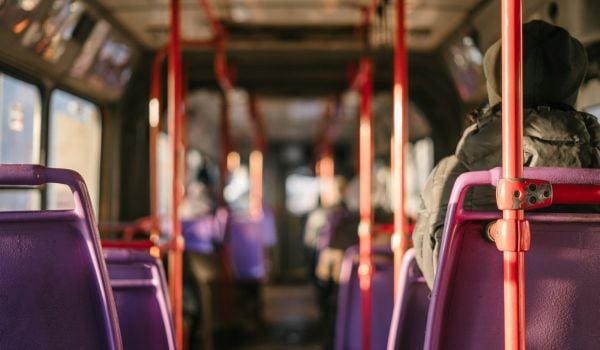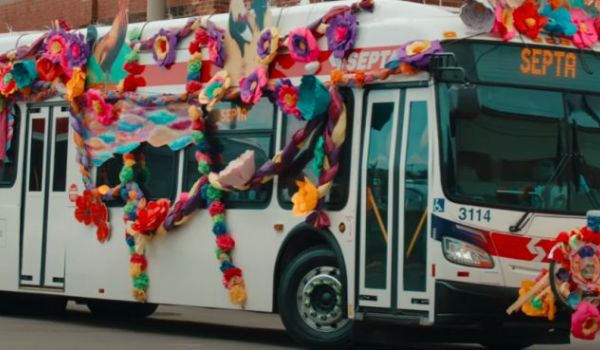Bus ridership is in decline in some of America’s largest cities. In Los Angeles, ridership dropped 8.9 percent last year to its lowest level in over a decade. New York City saw a 16 percent drop in bus ridership from 2002 to 2015. In Chicago, bus ridership decreased by over 25 million boardings from 2013 to 2015. In all three cities, train ridership has seen some growth in the past few years.
It’s a troubling trend for transit agencies who need viable bus service as part of their successful transit network. After all, subways and light rail will never be able to serve everyone and everywhere in a city.
The problem caught the attention of the National Association of City Transportation Officials (NACTO) and TransitCenter, who recently co-authored a white paper outlining their idea for improving buses and, in turn, increasing ridership again. They say every transit agency should adopt all-door boarding on their buses and do it as soon as possible.
“Buses have become less reliable and slower over the years,” says Alex Engel, NACTO Senior Program Associate. “It’s partly because traffic has increased. But one of the main things we identified was boarding time. One third of a bus’s time on route is spent waiting for people to board. A lot of that is fare collection.”
NACTO and TransitCenter’s report, “Better Boarding, Better Buses: Streamlining Boarding & Fares,” looks at the impact all-door bus boarding has had in cities that have implemented it and makes recommendations for how other cities can adopt the system.
As the name indicates, all-door boarding is a system in which bus riders can board the bus from any door. Riders can pay with a smart card at a front- or rear-door card reader, a card reader at the bus stop or by purchasing a ticket from a vending machine at the bus stop. Fare enforcement is typically handled by fare enforcement officers circulating the system checking for proof of payment, which has become the standard on many modern light-rail systems in the U.S.
The savings in time and money could be significant. The report calculates that bus operators in the U.S. spend a cumulative six million hours waiting at bus stops each year, which in turn costs agencies an estimated $700 million. The delays make sense. If 20 people are waiting to board a bus at a popular stop and it takes each person five to nine seconds, that adds up to over three minutes of waiting. Multiplied over a whole route, it totals to significant delay.
“The biggest advantages [of all-door boarding] are on the busiest lines. Those busy routes get dedicated bus lanes and signal prioritization. They should have the best boarding too,” says Engel.
San Francisco’s Municipal Transportation Agency (SFMTA) became the first transit system in North America to implement all-door bus boarding. They use a proof-of-payment system for fare collection. Since implementing, bus dwell times have fallen 37 percent and are 42 percent more consistent (meaning passengers can expect more standard wait times at a given bus stop). Overall, bus speeds increased 2 percent and fare evasion dropped from 9.5 percent to 7.9 percent.
New York, Seattle, Austin, Minneapolis and others have implemented all-door boarding on certain routes. To do so in New York, the MTA added two types of ticket vending machines at bus stops on Select Bus Service routes. One allows riders to use their MetroCard to pay. The other allows cash payment. Respectively, they cost $25,000 and $7,000 per machine.
Implementing all-door boarding is not inexpensive. You have to hire fare enforcement officers, install new infrastructure for off-bus payment or back door smart card payment. Systems that haven’t adopted smart card payment would ideally do so. But the report says, “the costs associated with fare inspection and ticket vending may be offset by higher ridership, increased fare revenue, and lower fare evasion.”
The Select Bus Service routes in New York saw dwell and overall trip time go down as well as lower fare evasion after adopting all-door boarding.
The drop in fare evasion makes sense. To avoid confrontation that could potential escalate into a dangerous situation, bus drivers rarely demand payment from passengers. Fare enforcement officers are less likely to let a non-payment slide since it’s their job to ensure passengers pay. As such, the report cautions that, “Fairness and the safety of both inspectors and riders is paramount; criminalizing riders will not result in an equitable transit system. Use a pro-passenger approach that makes transit a better experience for all riders.”
NACTO and TransitCenter want to see more cities adopting all-door boarding as soon as possible.
“A lot more cities should be doing this than currently are,” says Engel. “It’s a fairly easy change for most systems to do and the benefits are just a lot larger than you would think.”

Josh Cohen is Crosscut’s city reporter covering Seattle government, politics and the issues that shape life in the city.
Follow Josh .(JavaScript must be enabled to view this email address)
















